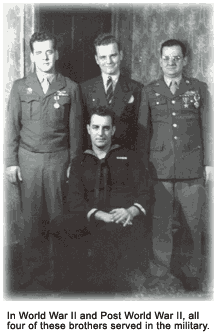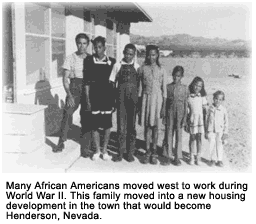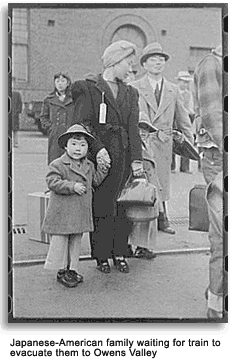With war comes devastation, depression, deprivation and death. World War II was uppermost in U.S. history with costs exceeding $350 billion and more than 292,000 American servicemen killed in action. The families on the home front were profoundly affected.
 An immediate political, psychological and economic shift took place following the Pearl Harbor Attack in 1941, because the United States found itself unprepared. The onset of war necessitated numerous adjustments; while American forces were fighting overseas or training in U.S. military camps, families also were fully engaged in the war effort. The American home front geared up for an all-out effort to rush into war production, and American society experienced dramatic changes.
The first major impact was felt with labor shortages when the men went off to war. More and more women now entered the work force. Once reserved for men, women now took up jobs in industry, and Rosie the Riveter became a popular icon in America. Widening their horizons, many women were now working full time and yet were still trying to maintain their home life. Attracted by waiting jobs, the number of high school dropouts increased significantly, resulting in the teenage work force swelling from one million to three million youngsters. In the meantime, federal inspectors ignored laws that regulated the employment of children.
Although the war had opened up new opportunities, it also brought much sadness and a far more serious reality regarding life in its normal state. Separation from fathers or sons left devastating effects, and in a sense, many felt robbed of their childhood. With the family shifting roles, each member was initially shocked and filled with mixed emotions. With added stresses it was an emotional time, to say the least — the American family would undoubtedly be changed forever.
An immediate political, psychological and economic shift took place following the Pearl Harbor Attack in 1941, because the United States found itself unprepared. The onset of war necessitated numerous adjustments; while American forces were fighting overseas or training in U.S. military camps, families also were fully engaged in the war effort. The American home front geared up for an all-out effort to rush into war production, and American society experienced dramatic changes.
The first major impact was felt with labor shortages when the men went off to war. More and more women now entered the work force. Once reserved for men, women now took up jobs in industry, and Rosie the Riveter became a popular icon in America. Widening their horizons, many women were now working full time and yet were still trying to maintain their home life. Attracted by waiting jobs, the number of high school dropouts increased significantly, resulting in the teenage work force swelling from one million to three million youngsters. In the meantime, federal inspectors ignored laws that regulated the employment of children.
Although the war had opened up new opportunities, it also brought much sadness and a far more serious reality regarding life in its normal state. Separation from fathers or sons left devastating effects, and in a sense, many felt robbed of their childhood. With the family shifting roles, each member was initially shocked and filled with mixed emotions. With added stresses it was an emotional time, to say the least — the American family would undoubtedly be changed forever.
 While adjusting to sacrifices, there was an added excitement about the war and uncertain fear of the consequences as well. The war brought vast changes: While there was an increase in marriages, job opportunities, and patriotism there was also a definite decline in morale among some Americans. Despite the increase in rising wages, poverty increased and some families were forced to move in search of work. Some 20 million people existed on the border of starvation as families faced a severe shortage of housing, lack of schools, hospitals and child-care facilities.
Those factors contributed to an upsurge in divorce, resulting in severe problems among the young. There were five million "war widows" trying to care for their children alone. Women employed outside the home left tens of thousands of "latchkey" children who were unsupervised much of the day. The rates of juvenile delinquency, venereal disease and truancy rose dramatically. The impact on the family was evident, attended by much anxiety about the breakdown of social values.
The war also aggravated systemic racism. On the West Coast there was actual hysteria when the war broke out. Thousands of Americans of Japanese descent were relocated and interned in camps. As for African Americans, they were usually "the last to be hired and the first to be fired." Low wages were the rule and even though they were accepted into the armed forces, they were assigned menial jobs. Discrimination continued its divisive role in society during that era.
With 25 percent of the American workers earning less than 64 cents per hour while skilled workers earned an average of $7 per hour, there was a definite division of rich versus poor citizens. Poverty increased as the federal deficit escalated. By 1945, longer working days were implemented, which inflicted more hardships on families — with women comprising 36 percent of the nation's work force.
The federal government encouraged Americans to conserve and recycle numerous items, so that factories could use them for wartime production materials. Getting their first taste of recycling, Americans were encouraged to salvage their tin cans, bottles, rubber items, paper, scrap metal, and even fats left over from cooking. The government conducted "salvage drives" throughout the country to aid the war effort.
Food rationing was the rallying cry on the American home front. The Office of Price Administration (OPA) was set up to determine rationing regulations. With the military as top priority, American families began to feel the pinch. There were now such substitute foods as dried powdered eggs and liquid paraffin instead of cooking oil. For those who violated the rationing rules, the punishment was strict.
"Victory Gardens" were started as the government encouraged Americans to grow their own food. Statewide competitions were conducted and winning recipes published to optimize use of home-grown vegetables. That endeavor was successful, and at one point during the war, 50 percent of the the nation's vegetables were grown in victory gardens. Although the nation’s farm population declined 17 percent during the war, modern farm machinery, good weather, and improved fertilizers actually increased agricultural production.
While adjusting to sacrifices, there was an added excitement about the war and uncertain fear of the consequences as well. The war brought vast changes: While there was an increase in marriages, job opportunities, and patriotism there was also a definite decline in morale among some Americans. Despite the increase in rising wages, poverty increased and some families were forced to move in search of work. Some 20 million people existed on the border of starvation as families faced a severe shortage of housing, lack of schools, hospitals and child-care facilities.
Those factors contributed to an upsurge in divorce, resulting in severe problems among the young. There were five million "war widows" trying to care for their children alone. Women employed outside the home left tens of thousands of "latchkey" children who were unsupervised much of the day. The rates of juvenile delinquency, venereal disease and truancy rose dramatically. The impact on the family was evident, attended by much anxiety about the breakdown of social values.
The war also aggravated systemic racism. On the West Coast there was actual hysteria when the war broke out. Thousands of Americans of Japanese descent were relocated and interned in camps. As for African Americans, they were usually "the last to be hired and the first to be fired." Low wages were the rule and even though they were accepted into the armed forces, they were assigned menial jobs. Discrimination continued its divisive role in society during that era.
With 25 percent of the American workers earning less than 64 cents per hour while skilled workers earned an average of $7 per hour, there was a definite division of rich versus poor citizens. Poverty increased as the federal deficit escalated. By 1945, longer working days were implemented, which inflicted more hardships on families — with women comprising 36 percent of the nation's work force.
The federal government encouraged Americans to conserve and recycle numerous items, so that factories could use them for wartime production materials. Getting their first taste of recycling, Americans were encouraged to salvage their tin cans, bottles, rubber items, paper, scrap metal, and even fats left over from cooking. The government conducted "salvage drives" throughout the country to aid the war effort.
Food rationing was the rallying cry on the American home front. The Office of Price Administration (OPA) was set up to determine rationing regulations. With the military as top priority, American families began to feel the pinch. There were now such substitute foods as dried powdered eggs and liquid paraffin instead of cooking oil. For those who violated the rationing rules, the punishment was strict.
"Victory Gardens" were started as the government encouraged Americans to grow their own food. Statewide competitions were conducted and winning recipes published to optimize use of home-grown vegetables. That endeavor was successful, and at one point during the war, 50 percent of the the nation's vegetables were grown in victory gardens. Although the nation’s farm population declined 17 percent during the war, modern farm machinery, good weather, and improved fertilizers actually increased agricultural production.
 The sale of war bonds and war stamps also helped the United States to stage a rapid economic recovery. Unfortunately, only about one third of the American people could afford to contribute to the cause. Changes were felt all the way to the top. As the federal government continued to cut funding for many social programs, many idealists left their government positions.
War necessities directly influenced American fashion. The War Production Board (WPB) became the nation’s premier clothing consultant in the spring of 1942. They influenced the appearance of civilian apparel by dictating the conservation of cloth and metal, changing the very style — especially women’s garments. Dependence on fewer materials led to the two-piece bathing suit. Nieman Marcus called them "patriotic chic."
Taxes skyrocketed. It was not possible to purchase a car because none were being produced. To obtain a telephone, one had to be in a critical occupation of the war effort — and yet the U.S. standard of living actually rose during those years! The country had pulled out of an awesome economic depression thanks to greatly expanded war production.
The end of the war revealed pent-up demand. Prices skyrocketed with the removal of Price Controls, but women stayed on the job to buy items needed for the family. The American Dream now became a reality as families found it possible to buy a home, a car, a washing machine, and to give their children everything they had been deprived of for so long. As a result of the war, the nation had become more urbanized because 1.5 million Americans had moved from rural areas into the cities. Women’s labor force participation continued to increase after the war and has been rising ever since.
The vast changes in wartime society and domestic adjustments are evident even today. The Americans who survived the devastating effects of World War II hold deeply embedded memories. Fortunately, they were willing to share them.
The sale of war bonds and war stamps also helped the United States to stage a rapid economic recovery. Unfortunately, only about one third of the American people could afford to contribute to the cause. Changes were felt all the way to the top. As the federal government continued to cut funding for many social programs, many idealists left their government positions.
War necessities directly influenced American fashion. The War Production Board (WPB) became the nation’s premier clothing consultant in the spring of 1942. They influenced the appearance of civilian apparel by dictating the conservation of cloth and metal, changing the very style — especially women’s garments. Dependence on fewer materials led to the two-piece bathing suit. Nieman Marcus called them "patriotic chic."
Taxes skyrocketed. It was not possible to purchase a car because none were being produced. To obtain a telephone, one had to be in a critical occupation of the war effort — and yet the U.S. standard of living actually rose during those years! The country had pulled out of an awesome economic depression thanks to greatly expanded war production.
The end of the war revealed pent-up demand. Prices skyrocketed with the removal of Price Controls, but women stayed on the job to buy items needed for the family. The American Dream now became a reality as families found it possible to buy a home, a car, a washing machine, and to give their children everything they had been deprived of for so long. As a result of the war, the nation had become more urbanized because 1.5 million Americans had moved from rural areas into the cities. Women’s labor force participation continued to increase after the war and has been rising ever since.
The vast changes in wartime society and domestic adjustments are evident even today. The Americans who survived the devastating effects of World War II hold deeply embedded memories. Fortunately, they were willing to share them.